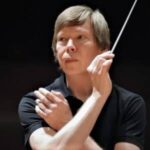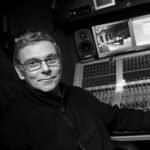Sound Of Eden Crescendo UNO Loudspeaker Review
by Sandu Vitalie/ October 20, 2021
Sun’s shinning outside, my kid’s playing in the courtyard, so I can get some peace of mind, I’m getting up and a warm coffee waits for me in the company of some blues and jazz. Can it get any better than this? A courier pays me a visit and drops a huge wooden box at my front door. What could it be? Another integrated or maybe a power amplifier I thought. I doubt it…as it’s bigger and looks way overly protective, there’s something else lurking inside. After opening it up, a fresh smell of wood hit my nostrils and what a beautiful sight: two lovely loudspeakers were waiting patiently for my arrival.
In a split second, I’ve remembered exchanging emails with Andis Ožets who founded Audiomotiv in Riga that sells loudspeakers, stereo components and acoustic treatments. I didn’t understand at first, I thought he is the man behind Tempo and Crescendo loudspeakers that you can spot on his web-store. Nope, he replied back to me. He seemed so confident in Sound Of Eden loudspeakers that he discarded the idea of carrying any other speaker brands and the rest is history. Later on, he acquainted me with the mastermind behind Sound Of Eden hand-made loudspeakers. Edijs Apenītis introduced himself as a music lover, as an engineer and then as the man behind Tempo and Crescendo line of loudspeakers. Before starting his own business, he created and restored countless of speakers for more than 10 years, but a time came to express his creative process, unleash his imagination and create something that he truly believes in.
Being curious by nature, I started asking questions about them. Why using passive radiators? Why leaning the cabinet on their back? Why using unusual driver materials? Why they need more juice to be driven at their fullest potential? And those were only few questions that popped into my head. Just recently they released a new line of loudspeakers, proving that Tempo series were only their fire starters as they had bigger plans down the road. For their newest Crescendo series, Edijs went with an aluminum / ceramic dome woofer and with a huge tweeter that uses the same materials, all inserted in a substantial enclosure that weights as much as 12 Kilos per piece. I was given the honors for a world-first review for their best passive bookshelves that are going for €2200, calling themselves Crescendo UNO. I’m a little sad that not a lot of people know about this Latvian brand, but I assure you…they deserve your full attention and if you have a chance for a listening session, please do so…You’ll thank me later.
Unboxing Experience
When a bookshelf loudspeaker is coming in a wooden box bolted with eight wood screws, you know you are dealing with something truly special. I’ve never seen something like this…hell even my Reference 3 didn’t come in a wooden box and that should tell you something. The whole affair is double boxed, filled in excess with plenty of foam as an extra protection measure. At the center of attention two speakers are sitting in peace, finished in matte-anthracite color. Standard versions are available in: anthracite, black, white, champagne and anthracite grey. Additionally, you can order them in polished walnut or mahogany finishes.
Build Quality & Looks
First of all, Crescendo UNO looks like a twin brother from a different mother to the Buchardt S400 that I reviewed some time ago. Both are using passive radiators for a better low-end delivery, both are leaned on their backs for a better waveguide control and this is where their similarities end as their masters used different cabinet sizes, finishes, crossovers, materials and drivers. As far as I know, this is the very first Crescendo UNO that left their factory, so I was unable to choose a color of my own, but I must say that anthracite has grown on me ever since. While it’s a neutral color and doesn’t attract a lot of attention, its higher grain should resist much longer even if your fluffy quadrupeds are rubbing their tails around them. Apart from that, their fit and finish is absolutely great, they used thicker MDF boards for a better dampening. Don’t get fooled by the bookshelf moniker as in reality, these are bigger to all my former bookshelves, including KEF LS50W and Buchardt S400. If you put them sideways you can clearly see that their cabinet is leaning back creating their unique look. It was done on purpose for a better waveguide control that will disperse the sounds around the room for a bigger stage size and for a nicer depth. Their back-plates are looking equally good, it was a surprise seeing top-class Jantzen terminals that are usually reserved for speakers costing two to three times more expensive. You can spot a massive 8” passive radiator, that in fact is much bigger to their woofer, something that is unusual and different to traditional speakers. If you closely inspect all the newest high-performance Bluetooth speakers from the likes of Vifa, Ultimate Ears and JBL, then you’ll observe that similar passive radiators were being used, so that smaller enclosures could push bigger amounts of air, making them sound grander to their cabinet size and giving a huge helping hand with the low-end extension, sustain and control.
That is exactly what makes Crescendo UNO so cool and unique looking to traditional loudspeakers. Edijs has done that on purpose by borrowing a lot of ideas from wireless speakers, traditional Hi-Fi speakers and by adding some of his own ideas into the mix. Apart from all this, Crescendo UNO looks like a standard 2-way bookshelf speaker that will absorb its own vibrations if you put them of a stand. Its bigger cabinet made a positive first impression on me, as usually speakers are sounding directly proportional to their sheer size. Measuring 400 mm tall by 225 mm wide by 345 mm deep and weighting 12 kilos a piece, make sure you have the right speaker stands and surface area to accommodate them. They will hardly work in a desktop environment, but they will if you have a bigger desk. Just make sure to leave at least half a meter behind them for a clearer bottom end.
Overall, they aren’t attracting a lot of eyes, reminding about Nordic furniture due to their neutral color palette and minimalist look.
Technology Inside Crescendo UNO
As I’ve mentioned before, Sound Of Eden used an unusual medium sized 6” woofer in here. But what’s so interesting about it you might ask? It uses an aluminum cast chassis for optimum strength and low compression, plus a geometrically reinforced ceramic cone on top that reduces break-up and optimizes its pistonic operation. Damping rubber surrounds it improving its push-pull operation, ultimately improving their transient response. A non-conductive fiber glass voice coil was used for minimum damping, silver lead wires and vented pole for a reduced compression. This particular driver can reach as low as 29 Hz at -5 dB and will easily play 40 Hz notes without dropping a single dB and that’s quite impressive.
Their tweeters are using absolutely the same materials, more exactly an aluminum / ceramic dome with a copper cap on top that reduces voice coil inductance. Both their tweeters and woofers are phase optimized for coherent high-frequency radiation. Their tweeters are flow optimized with vented pole pieces for a nicer coupling to the rear chamber.
Edijs explained that he tried multiple drivers made out of different materials, but these met his strict criteria and quality control. Their crossover point sits at 2.2 kHz, after which both their tweeters and woofers are working as a single driver.
With a large passive radiator on the back, Sound Of Eden team was able to reduce their cabinet size and that is one of the reasons some of the best wireless speakers are small in size, but big and enveloping sounding. Thanks to their passive radiators, Crescendo UNO are quite forgiving when it comes to placement near the wall, never suffering by the artifacts that can be induced by ported (bass-reflex) designs. Most importantly their radiators will awake a deeper low-end, that only bigger floorstanding speakers are capable of.
As for the crossover itself, Sound Of Eden selected some of the best audio-grade components that will stand the test of time. They’ve used highest-grade Mundorf MCap capacitors in the most crucial parts, never cutting corners and allowing for maximum sound quality to be achieved across the whole frequency range.
Most traditional speakers were created to be listened in a “sweet-spot” or as others are calling it On-Axis listening. Once you move Off-Axis, a lot of its acoustic performance goes to the garbage bin. Sound Of Eden wanted to be free on this nonsensical and archaic approach to music listening. Do you listen to your music staying exactly in the middle of your couch or are you moving around it? They made them sound as good Off-Axis and they do On-Axis, something that Buchardt Audio also did with their S400 speakers and there are many such examples. With Crescendo UNO, sounds would bounce off your walls, coming from different angles and not only from the speakers themselves. Alright everybody, I’m ready for some music so let’s hit some eardrums!
Sound Performance
Burn-In and System Matching
Considering the mastermind behind them, their long development time and costly bill of materials, I was expecting something special coming out of them. When Andis Ožets suggested that these would need at least a few days of burn-in to loosen up their membranes, unleashing their fullest potential and covering a much wider frequency response…I felt sad as I was hungry for some music, never resisting a day without it. Why not! I’ve replied back and I left them play for a few days, while trying a bunch of amplifiers and digital sources for an ultimate system matching.
It isn’t a secret to anyone that I’m in love with D/A converters and wherever I go, at least two units will travel with me. That’s the biggest fetish of mine (please don’t tell my wife) and one of the reasons you’ll see three or four digital sources constantly lying around me. From natural sounding R-2R units like Musician Aquarius and Rockna Wavelight, to big sounding creatures as Audiobyte HydraVox, to smooth as butter ones as Gold Note DS-10 Plus and then to ultra linear and honest sounding converters as Matrix Audio Element X and Gustard X26 PRO, everything was tested on the Crescendo UNO. Every single one shined brighter with few particular tracks, but the Italian was more interesting to me due to its immaculate wireless streaming capabilities. Thanks to its do-it-all and do-it-good approach, Florentine’s all-in-one unit become my weapon of choice.
Crescendo UNO is both a usual and unusual loudspeaker from multiple points of view and you should never judge them by their size, as in my case they demanded the cleanest and the most abundant power I could feed them. I started with small and affordable units like SMSL DA9 that provides some 90 Watts in 4 Ohms and it’s operating in Class-D. With such an affordable integrated amplifier something wasn’t clicking into place, female voices sounded like hungry kittens and electric guitars like broken violins. Bottom line is that DA9 was barely enough with the UNO’s. I had a decent SPL in my room, but their low-end was completely missing the action, they sounded shy and very polite down low, killing dynamics and sending it into clipping territory with demanding tracks. Its bigger brother SMSL SA400 worked by a whole lot better, awakening much better transients, pushing more air in my room and sending a nicer impact into my chest. It was good to almost great, but I disliked its above average detail retrieval and its weaker signal-to-noise ratio. It seems that lower tiered Class-D amplifiers are slowing down the Latvian masterpiece, decreasing their pace, rhythm and timing in the process and sending a critical hit in the slam department…as I was searching for higher dynamics even with my electronica tracks. No Bueno at all. I wanted to be sure that I’m not holding them back, so I left them powered for another week. Luckily my son watches cartoons a few hours a day, he did the honors for me, killing two birds with one stone.
When I’ve moved to a Burson Timekeeper 3i, Crescendo UNO awaken and suddenly became organic with vocals and life-like sounding in the midrange, pushing a considerably amount of bass energy in between the notes. Finally, a much nicer bass-slam returned back home, their speed improved to unrecognizable, starting showing signs of great potential. My daily driver KECES S300 power amplifier sounded extremely close to the Burson, it added just an additional layer of information in the bass, it put more meat on the bone and was able to push the Crescendo UNO to louder sound pressure levels. Having an oversized 1200 VA transformer and offering some 230W in 4 Ohms, delivering the first ones in magical Class-A, made the UNO’s even more impactful and meaner sounding down low, transforming a shy bookshelf loudspeaker, into fearless and impactful music making machines.
Later on, Andis suggested trying a Class-D Hypex NC1200 amplifier that provides mind-boggling specs as 700 Watts per channel in 4 Ohms, but I’ve replied back with a wild smile on my face that I’m using something better, that is cleaner sounding and even more powerful than that. I’m about two Benchmark AHB2 Class-AB mono amplifiers that are offering some ~740 juicy Watts in 4 Ohms and 380 Watts in 8 Ohms. Those are my thunder bringers, dopamine-injectors and heavyweight professional boxers that sometimes make me feel like I’m their punching bag. Although Crescendo UNO worked good to almost great with most of them, Benchmark creations made them jumpy, explosive at times, incredibly punchy and dynamic, while being clearer and more detailed sounding, tightly controlling their drivers down to sub-sonic levels of bass. Crescendo UNO literally transformed from an ugly looking larva into a beautiful butterfly, spreading their wings with higher power and showing what they are truly capable of.
Instead of a standard-sized bookshelf loudspeaker, UNO sounded like I had a medium-sized floorstanding speaker in front of me. I believe I’ve found the perfect system matching that counterbalanced their cons, making them fun and engaging, wide and open sounding at all times. Particularly with Crescendo UNO, I would stay away from low-power amplifiers, from most tube-based amplifiers and I would never user a shier or a slower sounding unit with them. UNO’s like more butter on those cookies, always craving for more power, for a better control and for higher dynamics.
Sound Signature & Tonality
Before getting myself a Christmas present last year, the KEF Reference 3 floorstanders that you can spot in plenty of reviews around here, I used to own bookshelf loudspeakers of different brands. I’ve been attracted mostly by Dynaudio, Focal, Dali, KEF, Natural Sound and Buchardt Audio, but naturally I cannot test them all and I’m sure that great sounding speakers can be found in many other brands and I believe that Sound Of Eden creations are up there with the nicest I’ve tried.
For starters, these are highly enjoyable and quite impactful sounding even if blues and jazz is your daily diet. There is a sense of greatness and spaciousness and that everything happens exactly at the right time and at the right place in the listening room. These are undeniably very fast sounding, decaying naturally, fully preserving the pace, rhythm and timing. While there are warmer and mellower sounding loudspeakers out there, Crescendo UNO wants to be remembered as honest and transparent to their core and as close to source material as possible. When Hoodoo Man Blues (Qobuz / Tidal / Spotify) started playing, part of my usual morning routine, I felt revigorated and energized for the rest of the day. UNO’s captured Well’s style that is both laidback and forceful. When playing his harmonica – I’ve felt it smoothly passing by, sounding raw and playful. The whole album felt deceptively casual and enormously powerful on the Crescendo UNO. This is a timeless record that is regularly voted as one the best electric blues ever recorded and UNO’s perfectly rendered its bad attitude.
If you power them up properly leaving a ton of headroom on tap, then prepare for a physical manifestation of its low-end delivery. You see, UNO is a two-way loudspeaker that relies on 6” woofers to playback all about that bass, but the cherry on top is that huge passive radiator that improved their low-end delivery and its dispersion in the room, pushing even more air around, making you think you are listening to a much bigger enclosure. With my former bookshelf loudspeakers, I knew exactly where I should sit on the couch for the best possible sound. Traditional speakers have a very defined sweet spot, with sound waves hitting my body frontally, but never from different angles. With UNO in place, everything increased dramatically and I no longer felt shackled by the sweet spot, I could sit anywhere on the couch and sounds would still come from different angles, filling the room nicely with musical notes. I’m getting sounds from multiple angles and surprisingly some of them hit me from behind. UNO knows how to play with my imagination, increasing the stage, deepening the performance, infusing some warmth, adding a lot of low-end where a speaker of this size would normally render just a tiny fraction of it.
I had a similar experience with the Buchardt S400, that were filling every corner of my room with sounds, adding weight and substance, ultimately improving the low-end delivery. UNO is exactly as big and enveloping sounding as S400, but they are considerably faster sounding and harder punching in the chest, always trying to impress with their immaculate transient response. While S400 was all about that bass and midrange presence, rolling-off tiny portions of the upper treble, Crescendo UNO are offering more details up top and anywhere else in the frequency response. That’s right folks! UNO can be considered as a detail-oriented loudspeaker, it’s an honest sounding pair, always searching for micro-nuances and delivering them instantly towards the listener. In the end, they provided a well-balanced sound, moving the spotlights towards micro detail-retrieval, despite never being analytical or harsh sounding, transforming a regular pair of bookshelves into a unique sounding duo.
Transient Response
Although many loudspeakers are using contrasting materials in their diaphragms, in my own experience only very rigid / stiff drivers as metallic ones were unlocking the fifth-gear when it came to speed of delivery and fast decays. There is a strong reason I’ve stopped at the KEF Reference 3 that fully satisfied my insatiable lust for lightning-fast transients. Crescendo UNO are using reinforced ceramic cones for optimum pistonic movements and a vented cast aluminum chassis for a higher strength and lower compression. Their tweeters are also using aluminum / ceramic domes with a copper cap on top to reduce voice coil inductance and all those things combined are telling me one thing: UNO’s are using stiff drivers, feed them enough juice and prepare to be punched in the chest over and over again. Their drivers are controlled by a crossover that uses only high-quality components as Mundorf caps that were specifically designed for audio applications. Their crossover was tuned in such a way, that their drivers would move in sync, preserving phase accuracy and most importantly never pushing the brakes when it comes to speedy dynamics.
While Buchardt’s S400 were only good when it came to acceleration and speed, UNO are on another level going fast and going wild once a higher-dynamic range track would hit my playlist. I’m not very much into modern pop music, but for giggles I’ve tried a few tracks and UNO’s were nicely keeping up with them, increasing and decreasing dynamics in a split second. The final outcome is a tight and accurate bass response, a great amount of definition and texture can be found in the midrange, plus a detailed top octave, preserving a big portion of the frequency response. When electronica music appeared on my playlist, they just kept on going, never losing a beat, sounding snappy and impactful with everything I’ve thrown at them. What’s more interesting is that even sub-bass made its appearance on a few tracks and I cannot ask for more from a speaker of this size. Those 8” passive radiators on their back improved their low-end delivery to unrecognizable and that was felt immediately after pressing play. In all fairness, how many bookshelf loudspeakers do you know that can reach as low as 40Hz (+/- 3 dB)? Although they sounded great out of many amplifiers, two Benchmark AHB2 put in a dual-mono configuration were something else entirely, making them almost explosive sounding at times, hitting my body with a higher force than usual, making it a very engaging and toe-tapping experience.
You can feel the power behind their drivers even while listening to oversimplified music as indie rock. Is This It by The Strokes (Qobuz / Tidal / Spotify) always works as dopamine for me in rainy mornings, when I’m down and need something to kick-start my day. Recorded in a basement studio in Manhattan, where air was thick due to cigarette smoke, The Strokes were recording their debut album that was paved in aggression and wrapped in black-leather cool. Being young and careless, there weren’t experienced musicians and I can’t possibly mention about a must-listen or about a reference recording. Using simplified riffs, three-note guitar solos, basic drumming skills playing in the background, nothing should be uplifting a cold-blooded audiophile as myself. Still, it sounds incredibly catchy and overly positive on the UNO, they created an ethereal soundscape, capable of building intensity and emotion that got me excited for what’s to come. The final upshot was a frantic experience, tightly constructed and urgently delivered into my ear drums. I’ve smiled and I couldn’t hold my feet still, gently tapping my right foot for 35 minutes. All I’ve heard was a raw, unpolished indie rock album that infused funk and soul elements into an alternative thinking rock band. In short, UNO’s delivered-in the raw emotional energy that I was craving for, talking directly with my soul and that is all I want from a pair of loudspeakers.
Soundstage & Depth
I still remember as if it was yesterday when I’ve moved from various speakers as Dynaudio, Wharfedale and KEF to the Buchardt S400 that were using massive passive radiators on their backs and for the first-time experiencing music from a different point of view. Those weren’t frontal sounding and weren’t bolting me to a defined sweet-spot on a sofa, as everything was approaching me from different angles, making them bigger and fuller sounding, that I could easily move around my couch and get exactly the same experience. While all my past loudspeakers felt like single-player experiences, S400 were ready to play tunes for a pack of music-loving pals, transforming a personal adventure into a multicultural and social activity. With Crescendo UNO I’m getting a very strong sense of Déjà-Vu, as these are sounding very alike, supplementing the air in the room, always striving for a bigger sound to their standard cabinet size. UNO’s resonated like I exchanged them with mid-sized floorstanding speakers, improving the scale and the final picture that I was looking at. Their phase-accurate pistonic movements created a clean picture in front of me with defined leading edges. I could easily pin-point where everything was located around me and I didn’t need to close my eyes for that to happen. Needless to say, UNO’s are extremely good when it comes to spatial cues, depth information and scale on all axes. When I was listening to the above-mentioned overcrowded and up-front sounding indie-rock album, instead of building my claustrophobia, they decompressed that music, added more air between each and every note, sounding twice as big to my former loudspeakers, placing everything where it belongs in the scenery, without overlapping notes on top of each other. If you leave a meter behind them, another one to their side and around 2.5 meters in-between, you’ll get a clearer image, nicer contours and leading edges, plus a tighter bass performance.
When Kind of Blue 50th Anniversary Edition by Miles Davis (Qobuz / Tidal /Spotify) started playing I felt hugged by a warm blanket of music, touching me and sending shivers through my spine. The whole album felt like taking a relaxed improvisation to the next level, extending the chords to more intricate patterns, playing them in synced phrases and breakneck tempos. The smoothness was so obvious that I’ve got a feeling that people were jamming for fun without playing their chords, there was an unprecedented freedom with music flying around, far and wide, with no borders and imaginary walls. I could listen to this album 100 times and I would still hear something new. It relaxed me so much, that I’ve grabbed a cigar and a glass of whiskey, melting myself into the couch, experiencing the pure definition of an ethereal sounding album that has no bounds and borders. This is why the album’s title fits so perfectly, the music itself is kind of blue to me, evoking melancholy and some unrestricted joy. This is a timeless and sensational album that easily highlighter the biggest strengths of the Crescendo UNO playing in a language that all know so well: the language of music.
Detail Retrieval
I’m not sure if their ceramic coated aluminum drivers are having anything to do with this chapter, or maybe those Mundorf caps are playing tricks on me, but these appeared very close to the source material, never staying in front of the musical signal, being clean and honest sounding at all times. Even without any kind of burn-in, it was clear to me that I am dealing with a detail-oriented loudspeaker that will never mess with the frequency response in any way. On my Big Rig, UNO’s were showing everything that was hiding in the shadows, there were unearthing substantial quantities of details, as often times with less than perfect recordings, I wanted to stop them showing uninvited in my tracks. When I was exchanging amplifiers, trying to find the best match, UNO’s exposed them all and ranked their cleanness individually. It isn’t a surprise to anyone that AHB2 was the cleanest and most detailed amplifier out of them all. If you are searching for a warm, overly-dense and meaty sound signature, you might look elsewhere, as these wouldn’t sugar coat your music, delivering only the truth and everything that is tied to it. Looking behind my past experiences with bookshelves, I can certainly say that these played on a higher level as far as detail retrieval goes. I can always count on their ability to show me everything good or bad happening behind my tracks. Yes, they increased the perception of detail in my music, without adding ringing in the treble, brightness or listening fatigue. I like listening to them, because I know they will extract the smallest nuances and microdetails, without adding grain in the treble or some nasty sharpness.
Hans Zimmer just released The Dune Sketchbook (Qobuz / Tidal / Spotify) from the accompanied Dune film that is running in theaters right now. If you didn’t see the movie, stop now and go see it, it’s worth your time and some more. If you think Interstellar soundtrack was intense, expansive and unusual sounding, wait until you experience his next masterpiece. Zimmer apparently crafted new musical instruments specifically for this soundtrack and that made me even more curious. The whole album drags you through ambiance and atmosphere, thought unsettling whispers, long drum solos and distorted vocals. This is a creepy and a nerve-wracking record that contains hundreds or even thousands of details and tiny nuances scattered all around. Although containing only 9 tracks, 5 of them are going way past the 10-minute mark and those were certainly the most peculiar and interesting ones. The sound of the storm sounded so real, that I almost felt dust and sand particles flying around me, popping in different places around the room. This is both a heavily distorted and a super clean soundtrack that will put to a hard test even a costlier stereo setup. There were an alarming number of raising crescendos throughout this album, but all that didn’t pose a problem, being perfectly rendered by the UNO. This is one of those albums that you need to hear on a clean sounding setup, that would always bring a little bit more, pushing you forward towards it.
All in all, UNO approached closely to the overall cleanness of my KEF Reference 3, but never surpassing them as they still reign supreme in my setup. Crescendo UNO performed exactly how I would define some clean, detailed and transparent sounding speakers, without going overboard to the clinical and overly linear side of things and if you are looking for micro-details and imperfections in your music, you’ll get them immediately after pressing play.
Frequency Response
Bass
While their midrange and treble performance wasn’t influenced by the source and amplifier that were driving them, their low-end delivery was directly tied to the amplifier that was doing all the heavy work. From them all, Burson Timekeeper 3i, KECES S300 and Benchmark AHB2 were making them fun, hard hitting and impactful. Two AHB2’s elevated their bass performance further, so much so that I would never use an active subwoofer with them. I’ve experienced deep rumbling bass, that reached even sub-bass territory, traveling at lightning-fast speeds and delivering natural decays. Bass notes were going in and out instantaneously, underlining that I’m dealing with a high-quality type of bass. Only on very rare occasions I wanted a better extension down low, but you can’t have them all with such a small cabinet size. Their passive radiators did miracles in my room, adding more oomph and fullness, but never distortion and muddiness. From my past experiences with bookshelves only Dynaudio Contour S1.4, Buchardt S400 and Natural Sound NS17 were as imposing and punchy sounding down low. When I’ve switched from Reference 3 to them, there was indeed a lower quantity traveling around, but I’ve never felt that it lost definition, weight and texture. While Crescendo UNO is nowhere near as impactful and hard punching in the bass, they came incredibly close, easily outperforming the likes of LS50 Meta or even Reference 1 that I’ve tried some time ago. As for tonality, I wouldn’t describe them having a warmer, a smoother or a mellower type of bass, they resemble a monitoring type of bass, that is cleaner, more honest, that cares for technicalities. You’ll hear layers and layers of bass coming one after the other and please forget about one-note bass lines, as UNO’s are playing at a higher level.
Midrange
Sound Of Eden tunes their loudspeakers with a reference tuning, choosing outstanding technicalities above anything else. They measure and then listen to their creations until perfections is being achieved. Some big words right here, but after seeing Jantzen speaker terminals and knowing about Mundorf caps in their crossovers, those words immediately resonated with me. These guys don’t play around with cheap components, hiding them below beautiful finishes, because in my humble opinion all the magic with Crescendo UNO happens on the inside. Sound Of Eden is not about making sounds, but about making music come to life and it was imperative going for a reference tuning with their Crescendo line. UNO’s have what I would describe as a natural sounding midrange that isn’t putting too much meat on the bone. These are smooth and musical, but are never going overboard à la Dynaudio or Natural Sound. If you want absolute relaxation of body and mind through a mellow and slow representation of your music, then UNO’s can’t deliver you that. These are neutral and quite linear, sometimes pushing that midrange closer to you, often placing it on the same level with the rest of the spectrum. Ceramic and aluminum drivers can render a sweet midrange presence, adding meaning and substance to your music, but those can’t make it overly smooth or dense sounding, luckily UNO’s won’t do that. There is just enough preserve to fully preserve the pitch of the human voice, musical instruments still carried plenty of emotions and I could easily discern their wooder bodies, their strings still wept and dragged me in, but those weren’t vibrating as long, due to a quicker decay of the notes. I felt some authority with male vocals and some sweetness with females, reminding that Uno can still highlight the beaty of their natural overtones. Again, don’t expect a bolder, a fuller and a forward midrange performance, as Sound Of Eden believes in a good old linearity, underlining that all musical notes should shine brightly and not only a small portion of them.
When Midnight Blue by Kenny Burrell (Qobuz / Tidal / Spotify) hit my playlist, my feet stopped from tapping, my mind slowed down and expanded the space and time continuum. A complete relaxation of body and mind settled in and the only thing remained to do is to add some more music into my playlist. I’m yet to hear a loudspeaker that isn’t transforming completely when this album starts playing. Yep, UNO can be serious and too honest at times with their detail retrieval, but this album made me focus on the grand scale of things, on the macro-dynamics and small shifts of the tempo. The naturalness and the liquidity were through the roof on this album, transforming a technical sounding loudspeaker into a music-making machine, teleporting my mind into my musical wonderland and leaving me in there for a few minutes.
Treble
While I can nitpick a tiny bit about their linear midrange performance, I’m glad that they didn’t touch their treble performance as I’m hearing it exactly at the same level. It isn’t elevated anywhere and most importantly it doesn’t roll-off too early how other loudspeaker builders are doing. Maybe when I’ll retire, I’ll probably surround myself with vacuum tubes and warm sounding loudspeakers, but right now I want to hear it all. I find their treble extended, even past top-octave and there is as much treble information as you could possibly desire. If you consider yourself a treble-head, then Crescendo UNO got you fully covered. I’ve drummed a long time ago and somehow my right foot always twitches when I’m listening to music, but especially when double-pedals are kicking-in. UNO rendered all that information in a clean and undistorted manner, so that I could easier focus on cymbals, snare drums, tambourines and the rest of percussion work. Their metallic bodies sounded very close to the real thing, never losing leading edges and their contours. There was only one thing that was gravely missing throughout my entire endeavor and that was brightness and listening fatigue. If I didn’t experience any of that on transparent and linear sounding gear, then I am pretty sure they would perform the same on your setups.
These are never rolling-off the upper treble, regardless of the music that is being played. Add some over-mastered and hot sounding recordings and you’ll start feeling uncomfortable in your listening chair, as these aren’t sweetening things up, these are truth tellers, be it bitter or sweet, so prepare to hear plenty of mastering errors and sometimes razor-sharp notes.
My Conclusion
Wrapping things up, this is my first contact with Sound Of Eden loudspeakers and hopefully it wouldn’t be my last. I’m kind of sad that my Crescendo UNO story is coming to an end, but their life cycle has just begun and maybe you’ll try them someday. I’ve smelled a wider sound to their cabinet size and they fully delivered on those promises. Nowadays there are plenty of speakers in the €1500 to €2500 price bracket, but only a few are worthy of their price tags. I don’t like promoting things that don’t deserve it, but Crescendo UNO are worth their €2200 asking price in full (which includes free worldwide shipping and 30-day money back guarantee as an added bonus). Would you like them or not? Well, it’s really simple: if you love your bass playful and impactful down low, your midrange clean and honest sounding, your trebles detailed and transparent without being offensive, while being surrounded by layers and sub-layers of music, then this is a very easy recommendation to make.
Feed them enough juice, put them in a revealing setup and these will be standing head and shoulders above many other units. They can serve as an upgrade path to your entry to mid-level music making boxes, until you wage wars with your wallet and go the high-end route.
Considering their good selection of components and outstanding build-quality, Silver Award was fully deserved! Congratulation to the team and I’m looking forward to their next doings!
I’ve saved the best for last, cooking a sweet deal for our readers and viewers, I partnered with their world-wide distributor and prepared a 10% OFF discount code that can be used on their official web-store. At checkout, please use Let’s Hit Some Eardrums discount code for a 10% OFF, that’s €220 off your Crescendo UNO order! Hurry up as only 10 pairs will be discounted. In case you get yourself a pair, please come back and leave a comment below, I’m dying to know how they perform in your setup!
PROS:
Big, Bold, Unusual looking
Thick MDF boards, solid build quality
Outstanding detail-retrieval and transparency
Feed them enough power and transient response will make a pleasant appearance
Excellent pace, rhythm and timing, great slam in the chest
Open wide soundstage, sounding much bigger to their cabinet size
Precise pin-point location of the notes around the room
Fills the gaps and corners with music, could easily be used even in 30 sq meter rooms
Chooses quality, over quantity in the Frequency Response
Goes for a linear and honest tuning, these wouldn’t sugar coat your music
Great engineering and internal components
A Great Value!
CONS:
These will require a powerful amp for the best results
System matching is important with them, I would use a warmer sounding source
ASSOCIATED EQUIPMENT:
DACs: Audiobyte HydraVox & HydraZap, Rockna Wavelight, Musician Aquarius, Matrix Audio Element X, Gold Note DS-10 Plus & PSU-10 Evo, Gustard X26 PRO, X16, Topping D90SE, E50
DAPs: FiiO M11 Plus LTD, M15, Shanling M8, M6 V.21
Headphone Amps: Flux Lab Acoustics Volot, Benchmark HPA4, Burson Soloist 3X, Musician Andromeda, SMSL SP400, Gustard H16. Topping L50
Preamps: Benchmark HPA4, Musician Monoceros, Topping PRE90
Power Amps: Benchmark AHB2 (x2), KECES S300, SMSL SA400, Burson Timekeeper 3i
Loudspeakers: Sound of Eden Crescendo UNO, KEF Reference 3, Natural Sound NS17
IEMs: FiiO FA9, FH7, FH5S, FD5, Meze Rai Penta, Rai Solo, LittleDot Cu KIS, Hiby Crystal 6 & others
Portable headphones: Sennheiser Momentum 2, Meze 99 Classics, Sony WH1000-XM4
Full-sized headphones: Hifiman Susvara, HE1000SE, Arya, HE400SE, Audeze LCD-4, Erzetich Phobos 2021, Erzetich Mania, Kennerton Wodan, Magni, Gjallarhorn, Vali, M12S, Ollo S4X Reference, Apos Caspian, Sendy Peacock & Aiva, Harmonicdyne Poseidon
Interconnects: QED Reference (x2), Topping TCX1 (x2)
Speaker cables: Kimber PR8, Audioquest Type4
Power Cables: Isotek EVO3 Premier (x3)
Balanced Isolation Power Conditioners: PLiXiR Elite BAC1500 (stereo setup), Elite BAC400 (headphone setup)











